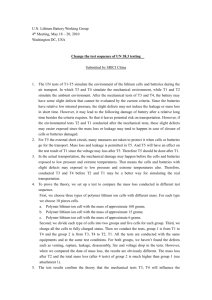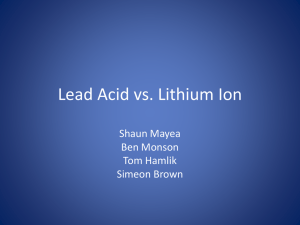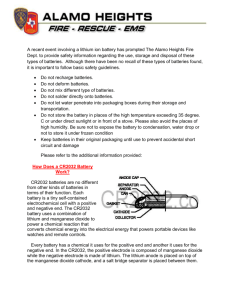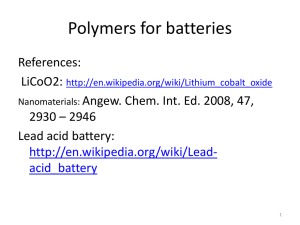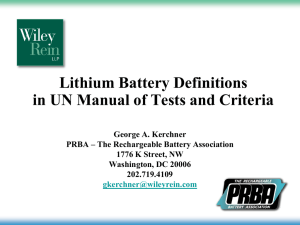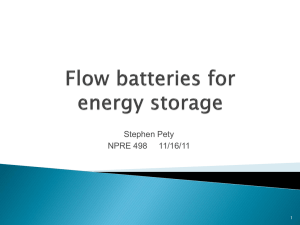the place of heat sensitive polymers in building a safer lithium ion
advertisement
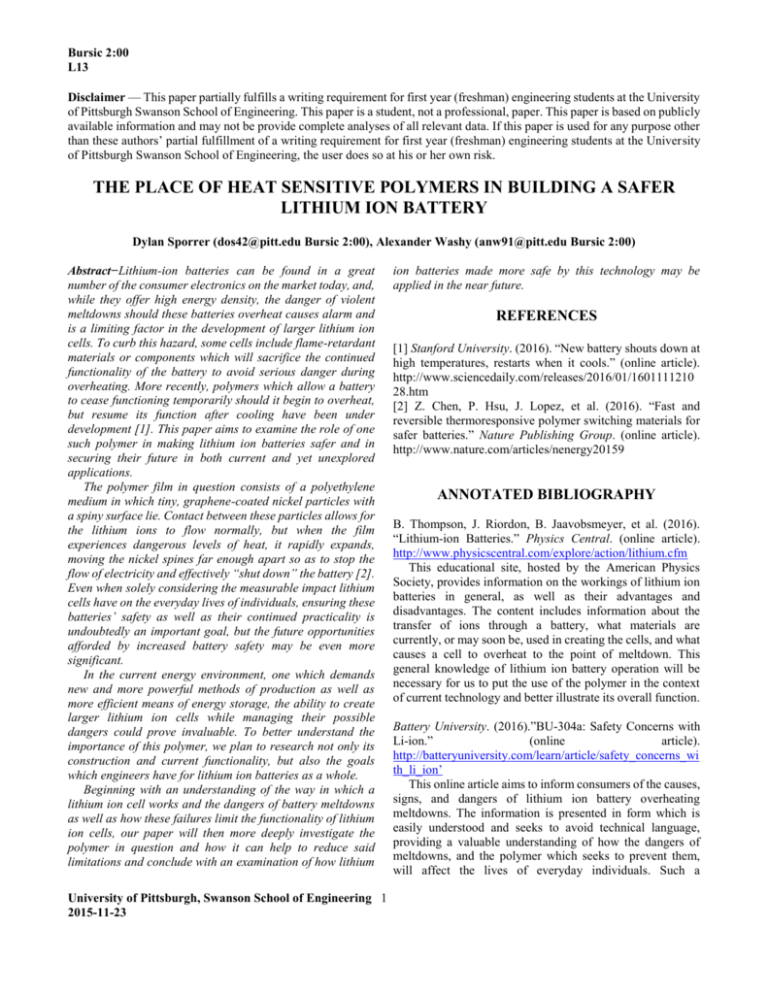
Bursic 2:00 L13 Disclaimer — This paper partially fulfills a writing requirement for first year (freshman) engineering students at the University of Pittsburgh Swanson School of Engineering. This paper is a student, not a professional, paper. This paper is based on publicly available information and may not be provide complete analyses of all relevant data. If this paper is used for any purpose other than these authors’ partial fulfillment of a writing requirement for first year (freshman) engineering students at the University of Pittsburgh Swanson School of Engineering, the user does so at his or her own risk. THE PLACE OF HEAT SENSITIVE POLYMERS IN BUILDING A SAFER LITHIUM ION BATTERY Dylan Sporrer (dos42@pitt.edu Bursic 2:00), Alexander Washy (anw91@pitt.edu Bursic 2:00) Abstract−Lithium-ion batteries can be found in a great number of the consumer electronics on the market today, and, while they offer high energy density, the danger of violent meltdowns should these batteries overheat causes alarm and is a limiting factor in the development of larger lithium ion cells. To curb this hazard, some cells include flame-retardant materials or components which will sacrifice the continued functionality of the battery to avoid serious danger during overheating. More recently, polymers which allow a battery to cease functioning temporarily should it begin to overheat, but resume its function after cooling have been under development [1]. This paper aims to examine the role of one such polymer in making lithium ion batteries safer and in securing their future in both current and yet unexplored applications. The polymer film in question consists of a polyethylene medium in which tiny, graphene-coated nickel particles with a spiny surface lie. Contact between these particles allows for the lithium ions to flow normally, but when the film experiences dangerous levels of heat, it rapidly expands, moving the nickel spines far enough apart so as to stop the flow of electricity and effectively “shut down” the battery [2]. Even when solely considering the measurable impact lithium cells have on the everyday lives of individuals, ensuring these batteries’ safety as well as their continued practicality is undoubtedly an important goal, but the future opportunities afforded by increased battery safety may be even more significant. In the current energy environment, one which demands new and more powerful methods of production as well as more efficient means of energy storage, the ability to create larger lithium ion cells while managing their possible dangers could prove invaluable. To better understand the importance of this polymer, we plan to research not only its construction and current functionality, but also the goals which engineers have for lithium ion batteries as a whole. Beginning with an understanding of the way in which a lithium ion cell works and the dangers of battery meltdowns as well as how these failures limit the functionality of lithium ion cells, our paper will then more deeply investigate the polymer in question and how it can help to reduce said limitations and conclude with an examination of how lithium University of Pittsburgh, Swanson School of Engineering 1 2015-11-23 ion batteries made more safe by this technology may be applied in the near future. REFERENCES [1] Stanford University. (2016). “New battery shouts down at high temperatures, restarts when it cools.” (online article). http://www.sciencedaily.com/releases/2016/01/1601111210 28.htm [2] Z. Chen, P. Hsu, J. Lopez, et al. (2016). “Fast and reversible thermoresponsive polymer switching materials for safer batteries.” Nature Publishing Group. (online article). http://www.nature.com/articles/nenergy20159 ANNOTATED BIBLIOGRAPHY B. Thompson, J. Riordon, B. Jaavobsmeyer, et al. (2016). “Lithium-ion Batteries.” Physics Central. (online article). http://www.physicscentral.com/explore/action/lithium.cfm This educational site, hosted by the American Physics Society, provides information on the workings of lithium ion batteries in general, as well as their advantages and disadvantages. The content includes information about the transfer of ions through a battery, what materials are currently, or may soon be, used in creating the cells, and what causes a cell to overheat to the point of meltdown. This general knowledge of lithium ion battery operation will be necessary for us to put the use of the polymer in the context of current technology and better illustrate its overall function. Battery University. (2016).”BU-304a: Safety Concerns with Li-ion.” (online article). http://batteryuniversity.com/learn/article/safety_concerns_wi th_li_ion’ This online article aims to inform consumers of the causes, signs, and dangers of lithium ion battery overheating meltdowns. The information is presented in form which is easily understood and seeks to avoid technical language, providing a valuable understanding of how the dangers of meltdowns, and the polymer which seeks to prevent them, will affect the lives of everyday individuals. Such a Dylan Sporrer, Alexander Washy perspective will be useful in connecting the information presented in our paper to the practical application of this technology and thus its importance to engineers of today. This article, from a news site specializing in current science and technology stories, covers the primary function of a recently developed polymer put to use in lithium ion cells. The article briefly covers how the polymer expands at high temperatures to cease the battery’s function, and makes note of how this polymer builds upon previously developed technologies to prevent cell meltdowns. The information in this article will be useful in giving a broad understanding of this technology in the paper’s introduction as well as how this technology innovates upon past discoveries. Erickson Evan M., Ghanty Chandan, Aurbach Doron. (2014). “New horizons for conventional lithium ion battery technology.” Journal of Physical Chemistry. (online article). http://pubs.acs.org.pitt.idm.oclc.org/doi/10.1021/jz501387m A professional article published by the American Chemical Society which investigates the issues which limit lithium ion cell usage as the primary power source for electric vehicles. The source goes on to provide an overview of anode materials, with silicon based anodes garnering particular attention, as well as speculate on practical applications of these batteries in hybrid vehicles despite their limitations. The information within will allow us to build upon the belief that safer battery technology is important in advancing the capabilities of lithium ion cells as whole. University of Pittsburgh ULS. (2014). “Choosing a Topic”. University of Pittsburgh. (online video). http://www.library.pitt.edu/other/files/il/fresheng/index.html This informational video created by the University of Pittsburgh seeks to help students define a sufficiently narrow topic area for their conference papers. By providing examples of topics as well as the proper way to carry out the selection process, the video creates a framework from which one may develop their paper. We have implemented the video into our paper by following its guidelines regarding topic selection and choosing a specific topic which still has relevance to engineering as a whole. N. Nitta, F. Wu, J. Lee, et al. (2015). “Li-ion battery materials: present and future.” Materials Today. (online article). http://www.sciencedirect.com/science/article/pii/S13697021 14004118 A scientific article published in Materials Today which gives both an in-depth review of the effectiveness of current materials used in lithium ion battery construction and a look into the future of battery construction. The article primarily examines the materials which make up the cathode and anode of the battery and their associated charge capacity, discharge potential, and longevity. Such detailed technical information on battery construction will allow us to build upon the general information presented in the American Physics Society source and the look at future materials will bridge the paper into our examination of the future uses of lithium ion batteries. Z. Chen, P. Hsu, J. Lopez, et al. (2016). “Fast and reversible thermoresponsive polymer switching materials for safer batteries.” Nature Publishing Group. (online article). http://www.nature.com/articles/nenergy20159 A professional scientific article published by the development team for the polymer which will be the focus of our paper which goes into great detail about the technology’s design and operation. This article contains all necessary information about the development of the polymer, including specific data on its operation. This source will provide the bulk of the technical information required to examine the polymer in our paper. Scrosati Bruno, Hassoun Jusef, Sun Yang-Kook. (2011). “Lithium-Ion Batteries. A look into the future.” Energy Environ Sci. (article). http://pubs.rsc.org.pitt.idm.oclc.org/en/content/articlepdf/20 11/ee/c1ee01388b This professionally published research article provides an examination of recent advances made concerning lithium ion cells, possible future materials or capabilities, and the issue which limit their implementation. The text presents data on the varying capabilities of metals when used in anode construction and touches on the need for higher performance batteries when considered their application in hybrid vehicles. The information from this source will help us to display the future of lithium cells, and the importance of the researched technology in maintaining their safety in this future. Stanford University. (2016). “New battery shouts down at high temperatures, restarts when it cools.” (online article). http://www.sciencedaily.com/releases/2016/01/1601111210 28.htm 2




